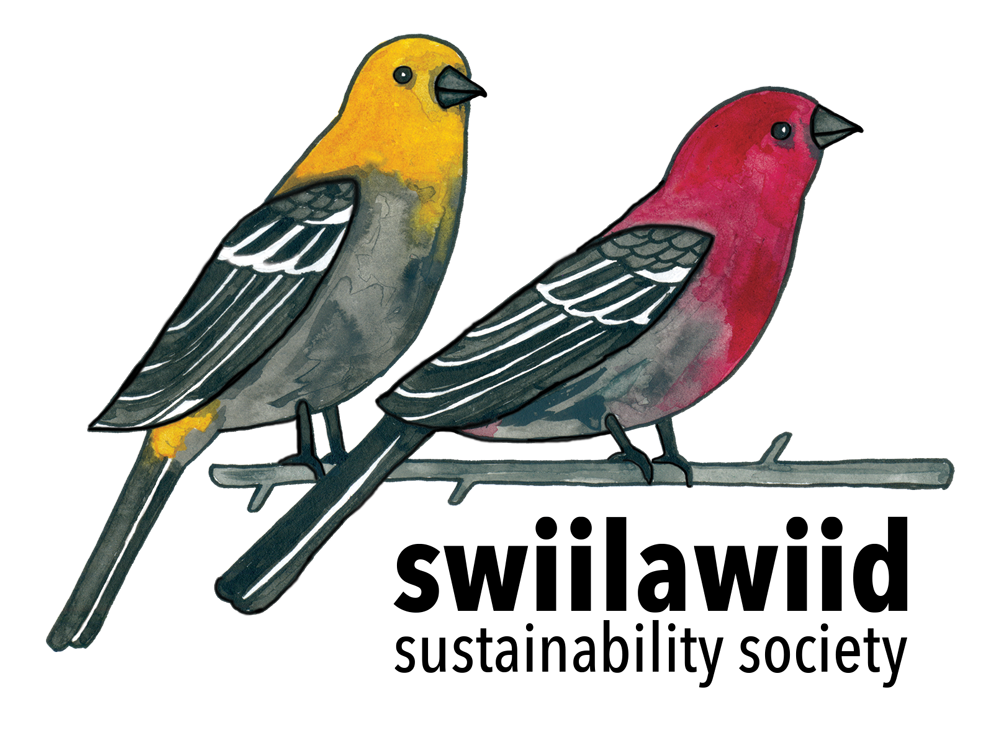Photo: Jen Bailey
GANDLAAY XAAL K’AAGASDLL
WATER BURNT DRY
This article was originally published in the Hlk'yak'ii exhibition catalogue (Haida Gwaii Museum Press, 2021)
It is said that ecosystem degradation and population density can lead to epidemicsi. The most severe pandemic of the 20th century was the 1918 Flu, with an estimated population loss of 50 millionii. The most severe pandemic of the 21st century to date is the novel Coronavirus (COVID-19). As of December 2021, population loss is over 5 millioniii.
Haida Gwaii navigated the virus by isolating itself from the rest of the world, and its residents from each other, for over a year. During this time, our constant companion was rain. In June 2021, as we emerged from our isolation, so did the sun, inviting us outside to gather with family and friends. But it seemed like all around us, the world was burning.
Between the end of June and mid-July, an unprecedented heatwave resulted in some of the highest temperatures ever recorded in Western North Americaiv. The event has been described as “the most anomalous regional extreme heat event to occur anywhere on Earth since temperature records began.”v The impacts on the Northwest Coast were devastating. Within a one-week period, hundreds of vulnerable people lost their lives to the extreme heatwavevi, the town of Lytton shattered long-standing national heat records and burned to the groundvii; and it is estimated that over one billion sea creatures were literally cooked to deathviii. By mid-July over 300 forest fires were burning in the colonial state of BC, with almost 30 considered as threats to public safetyix. The other side of the world was no different. By August, Southern Europe was experiencing an extreme heatwave that saw Greece and Turkey burn, and many other countries go on alertx.
Of course, we know that this is not the first time the world has been on fire. Each year we are witness to an intense fire season. Over the past couple of years, these fires have increased in astonishing numbers and have had devastating impacts, such as Australia’s bushfire crisis, where nearly three billion animals were harmed or lost their lives within a 10-month periodxi. Between deforestation and the current climate crisis, the Amazon Rainforest is burning like never before, with the entire River Plate Basin on the brink of becoming desert landxii. The heat has even travelled to the Arctic, thawing Siberia’s frozen tundra then setting it on firexiii. Last summer, the smoke of the California forest fires travelled up the Pacific Coast, staining Haida Gwaii’s sunsets. Devastating tornados and flooding are also on the rise, as experienced this fall. This is our new reality.
On August 9, 2021, the Intergovernmental Panel on Climate Change (IPCC)xiv released its Sixth Assessment Report, which unequivocally points to human activity having caused our current climate crisis, and that this crisis is absolutely affecting every corner of the planet’s land, air, and sea. The report states that CO2 levels are higher than any time in the last two million years, and that much of the damage is irreversible, and has called the situation a “code red for humanity.”xv
There are many types of greenhouse gas emissions (GHGs), CO2 being the greatest. In 2019, global CO2 emissions were over 35 billion tonnes. Canada contributed over 576 million tonnesxvi, with approximately 45% caused by burning fuel for electricity and heatxvii.
The oil and gas industry, as well as transport, is the largest source of GHGs in Canada. Together they account for over 50% of total emissionsxviii, mainly due to expansion of the tar sands and the production of crude oil, which has increased 87% over the last 30 yearsxix. Since 2018, the Canadian government has subsidized the Coastal Gas pipeline, the Keystone XL pipeline and the Trans Mountain pipeline, and the BC government has supported and promoted LNG projects for decades.
Haida Gwaii is a small piece of the pie when it comes to global GHGs, but we are still part of the problem. Each year, 30 million litres of diesel and gas are shipped to Haida Gwaii for a variety of needs, including fuel for the two power stations on Island: one in the north-end, one in the south. While hydro powers about 80% of the southern grid, the northern grid is currently powered solely by diesel. While some local organizations and homes have turned to renewable energy, 65% of our residential electricity comes from burning diesel. This equates to approximately 10 million litres per year and does not include local government or institutional consumptionxx.
Despite all this, we can still make a difference. Now is the time to build community power!
– Jisgang Nika Collison December, 2021
ii 1918 Pandemic (H1N1 virus), Centers for Disease Control and Prevention (2019)
iii www.worldometers.info/coronavirus/
iv 2021 Western North America heat wave, Wikipedia (2021)
vii Canada Lytton: Heatwave record village overwhelmingly burned in wildfire, BBC News (2021)
xi Australia's fires 'killed or harmed three billion animals', BBC (2021)
xii The Amazon rainforest: could it become a desert? (Barrett), Science Focus (2021)
xiii As Frozen Land Burns (Troianovski), New York Times (2021)
xiv The Intergovernmental Panel on Climate Change (IPCC), created by the UN, is the definitive authority on climate change and is comprised of hundreds of climate scientists.
xvi CO2 emissions, Our World in Data (2021)
xvii Where Do Canada’s Greenhouse Gas Emissions Come From? Prairie Climate Centre (2018)
xviii AR6 Climate Change 2021: The Physical Science Basis, IPCC (2021)
xix Greenhouse gas emissions, Government of Canada (2021)
xx Energy on Haida Gwaii, Swiilawiid Sustainability Society (n.d.) <swiilawiid.org>

